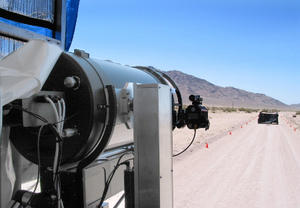Plastic lasers shed light on hidden explosives
Detecting hidden explosives is a difficult task but now researchers in the United Kingdom have developed a new way of detecting them, with a laser sensor capable of detecting molecules of explosives at concentrations of 10 parts per billion (ppb) or less

Explosive detection at a distance using laser system // Source: eetd.lbl.gov
Detecting hidden explosives is a difficult task but now researchers in the United Kingdom have developed a new way of detecting them, with a laser sensor capable of detecting molecules of explosives at concentrations of 10 parts per billion (ppb) or less.
The laser sensor, developed by physicists from the University of St Andrews in Fife, Scotland, relies on the fact that when a type of plastic called polyfluorene is “pumped” with photons of light from a light source it emits laser light. When molecules of the vapors emitted by explosives such as TNT are present, they interfere with the laser light, switching off the emission, and the interference can be measured.
One of the scientists, Dr. Graham Turnbull, explained that there is a dilute, weak cloud of vapors of nitroaromatic-based explosive molecules above an explosive device. He said the laser could be thought of as an “artificial nose for a robot dog.”
In the study a plastic laser was exposed to 1,4-dinitribenzene (DNB) vapors at 9.8 ppb concentration. The light emitted by the laser decreased rapidly, allowing for detection within seconds of the exposure. After 4-5 minutes the response had slowed and then flattened off, which the researchers suggest is due to the vapor molecules interacting with the surface of the polyfluorene. The laser took three and a half hours to recover in air, but only three minutes if nitrogen gas was flushed through it and 20 seconds if purged under a vacuum.
The plastic polyfluorene is a cheap material, which is an obvious advantage for a device designed to detect explosives. Dr. Turnbull said that while similar techniques using organic semiconductor lasers had been looked at before, this is the first time scientists have used a polyfluorene laser, and its use enables much lower concentrations of vapors to be detected.
Organic semiconductor lasers detect explosive vapors because of a chemical interaction between the vapor and the semiconductor in which electrons are transferred from the semiconductor to the electron-deficient vapor molecules. It is this transfer of electrons that reduces the light emitted by the laser. The same electron-transfer effect occurs with the new polyfluorene laser.
The drawback with the laser sensors is that the explosives must be in the very near vicinity, which limits its use for humans, but they could prove extremely useful for applications such as roadside bomb detection in Iraq and Afghanistan, for security checkpoints, luggage screening in airports, and for bomb disposal robots generally. The system could also be used in conjunction with remotely controlled robots for detecting land mines, which are still a danger to people in areas such as Southeast Asia.
-Read more in Ying Yang et al., “Sensitive Explosive Vapor Detection with Polyfluorene Lasers,” Advanced Functional Materials (25 May 2010) (DOI:10.1002/adfm.200901904)
